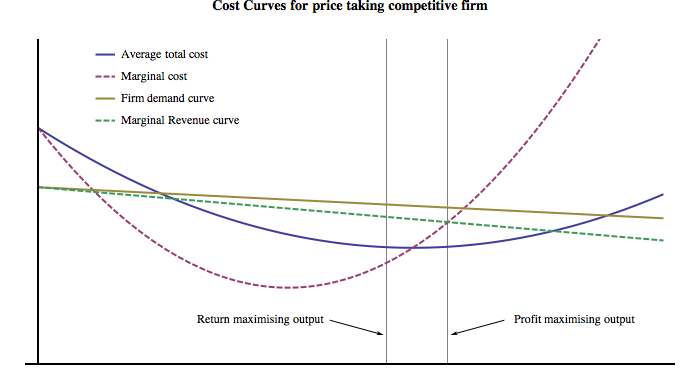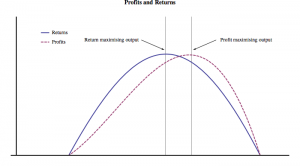
In neoclassical market theory firms are profit-maximisers. That sounds intuitive enough – until you realise exactly how economists define profits and the problems it creates for the whole market model.
In this series of posts I will develop my ideas about an improved market model incorporating return-seeking firms at its core, rather than profit-maximising firms, can overcome some of the key shortcomings of the neoclassical market model. All comments and criticisms are welcomed.
The first shortcoming is the shape of the supply curve. The neoclassical model assumes they slope upwards both for a firm and for the market as a whole. Yet at best they are flat, and most likely they are downward sloping over any useful period of analysis.
A simple explanation is that market supply curves are the horizontal summation of supply curves for each firm. Unfortunately this means that supply curves for each firm must be bizarrely steep in markets with very high numbers of firms if the market supply curve is still to be assumed to be upward sloping. Indeed, at the limit of an infinite number of firms, the individual supply curve must be vertical to maintain an upward-sloping market supply curve, and individual firm production would be zero.
Economists get to assume away problems like this by invoking the idea of a ‘short run’, where capital is fixed and maybe these assumptions could hold, versus a ‘long run’ where the supply curve is flat and so is the demand curve, and you basically have no model left.
So how does the central concept of profit-maximisation lead to such confusion? First we need to consider what economists mean by profits. Basically profits are revenues minus costs. But remember, there is no time in the theory. Imagine a discounted cashflow model with time periods out to infinity, then discount all rows of future period cashflows back to present values. At what rate do we discount? The normal rate. Where does the normal rate come from? Essentially no one knows. But that is a question for a later Part in this series.
Leaving the issue of time to one side for a moment, we can then work out using this single period the revenue minus the costs, and call that profit. So far so good. This is exactly a Net Present Value (NPV) calculation at the moment.
But do firms really maximise NPV? This is a serious question that lies at the crux of the whole theory of markets.
Consider a firm investment decision. Option 1: Spend $100 to generate revenues of $110, making a $10 profit. Option 2: Spend $200 to generate $211 revenue and $11 profit.
The profit, or NPV of Option 2 (since these are already discounted values) is $11 compared to $10 in Option 1. If an economist was to advise this firm they would say take Option 2 because you make more money. But of course twice the funds are required initially to make that extra dollar.
Option 1 however, has a higher internal rate of return by construction.
To be clear, the NPV value is the time-condensed version of revenue minus cost, measured in dollars. The IRR is the revenue minus cost per cost per time, or more simply, the percentage return per period.
I fail to see how investors can be return-seeking[1], squeezing the most out of every dollar they invest, while firms somehow behave with a different financial objective. Surely if investors buying the firm are return-seeking then firms themselves would operate with that objective.
The economic rejoinder is that since there are no other positive profit investment options in equilibrium, firms are better off spending the extra $100 to make $1, than nothing at all. The only alternative option of no returns arises from the assumption that all capital is in already in use elsewhere. So you must squeeze all you have out of your current capital. Unfortunately this usually requires more labour, but the model also says that labour is fully employed elsewhere. In fact, there is no curve as such in the neoclassical model, just the point where production takes place.
But in the real world capital is not fixed. Investing in new capital[2] is a decision regularly made by all firms. And as Sraffa so clearly described, the output of many markets is the capital input to another – the production of commodities by means of commodities. Thus capital cannot be fixed except in the most extreme short-term conditions [3]. And under these conditions, the short run neoclassical model might be of use. But firms won’t generally plan to operate in this way, and this only occurs during unforeseen short term “shocks” where prices are able to be adjusted quickly. This is a rare situation that is nested within the broader model of return-seeking firms.
To take the neoclassical model seriously you also have to believe that we are in, and always in, equilibrium to make that case. Even if one market is out of equilibrium, the neoclassical model has nothing to say about profits in any other markets – either all markets are in equilibrium, or none.
But enough about the shortcomings of the neoclassical theory of markets for the moment. Just what does this mean for the next wave of economic theory?
It means that the level of output at which a firm produces is far less than predicted by the optimal decision to equate marginal revenue with marginal cost. As Alan Blinder’s famous research showed, 89% of firms operate on the downward section of their cost curve, despite the theoretical prediction that this would only occur in natural monopolies. But in a model of return-seeking firms, producing on the downward-sloping section of cost curve maximises returns if firms face a downwards sloping demand curve for their product.
Compared to the neoclassical model, real firms seem to over-invest in capital and/or under produce.
The two graphs below show this principle using the fundamental cost curves for a firm with a given level of capital [4]. When a firm follows the economist’s advice they choose a lower rate of return on their investments but higher output.
Yet I know one situation where the economic model holds – property development. Because the property developer has the monopoly on their land, maximising NPV also maximises their return since they can capture all the surplus. If they have the option to spend $100 to make an extra $1 above a ‘normal profit’ they will. This situation actually complies with the assumptions of the neoclassical model; that capital is fixed, in this case land, and firms will maximise the profit associated with that capital. This situation is just one of many that nests within the framework of return-seeking firms. But the distinction becomes very important when I get to optimal timing of irreversible investment choices (when to build) for land owners in a future post.
Unfortunately it is difficult to translate even this minor change into the broader neoclassical theory without also revisiting and modifying (improving) many other critical assumptions in that theory. In future posts I hope to consider a few other critical points.
1. Where do profits come from? In the neoclassical model the normal rate of return is assumed to arise from some other market. But fundamentally that other market will be modelled with the same assumption of normal returns – the circularity problem means there is no origin of profits in the economic vernacular.
2. What are economic rents versus profits versus returns, and why don’t rent arise in the neoclassical model.
3. Competition is assumed to have already occurred in the model, and it offers little insight into the competitive opportunities available to firms. Competition is merely a static choice of output level.
4. The fundamental model has no important implications for asset markets and their impact on new physical capital investment.
fn[1]: I use the term return-seeking because maximisation usually implies a single unique solution. However the realities of uncertainty and the complex interactions in the economy mean that at best firms “seek out” high returns.
fn[2]: I mean capital in terms of inputs into production that don’t physically end up in the product, such as buildings, machines, vehicles, tools etc, as opposed to material inputs
fn[3]: Depending on the market. Some industries with large scale capital projects might temporarily see these conditions (such as resources).
fn[4]: Horizontal axis is output, vertical axis in first graph is cost/price in $. The second graph has two vertical axes – return in %, and profit in $. The scale of the two lines are not comparable, only the positions of the peaks.
Please share this article. Tips, suggestions, comments and requests to [email protected] + follow me on Twitter @rumplestatskin

